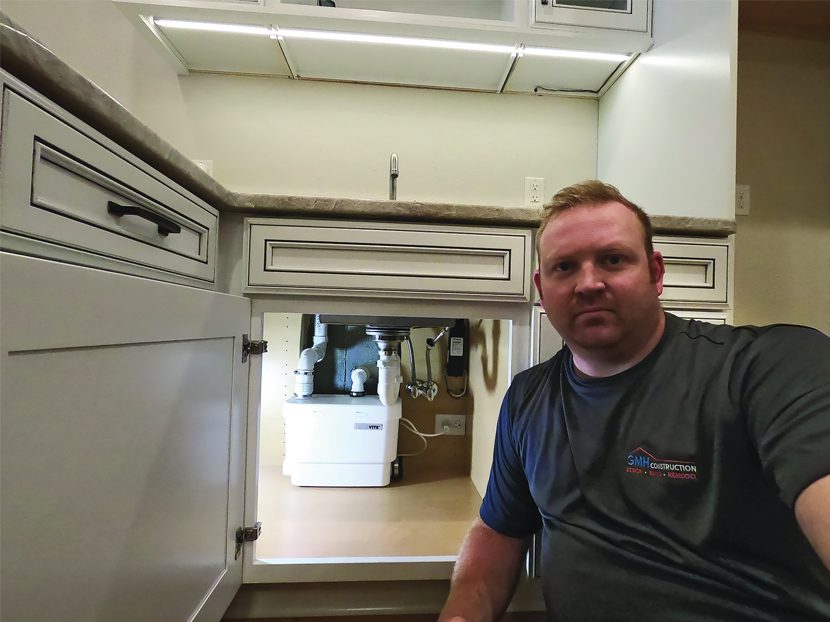Basement Bar Drainage Dilemma
Avoiding the hassle and expense of busting through concrete, Wisconsin contractors install a greywater pump in a lakefront home.

Hartland, Wis.-based GMH Construction, a small family-owned contracting business, found its passion for remodeling homes in 1995. While the firm specializes in bathrooms and kitchens, working in Wisconsin offers them numerous opportunities for basement remodeling jobs as well. Dane Perkins, project manager and co-owner, and his father oversee the day-to-day operations of GMH. Not only do they take pride in their work, but they truly enjoy doing it together.
Perkins also enjoys showcasing his projects and daily experiences of being a remodeler. “The Remodelers Life” is his Instagram page (www.instagram.com/the.remodelers.life) and YouTube channel (https://bit.ly/36NM0U5) where he shares product reviews and project profiles with his viewers. Perkins recently took his virtual audience along with him to a jobsite that involved finishing the basement of a beautiful lakefront home.
Built about five years prior, the homeowners wanted a basement that would match the high-end upper levels they put so much time and effort into. Specifically, they wanted a basement bar for entertaining guests. To complete the bar, Perkins and his crew needed to add a bar sink.
However, GMH faced a challenge. The drainage pipe coming from the new sink would have to connect to the existing basement bathroom plumbing. To accomplish this, Perkins and his crew had two options.
The first was breaking through the basement’s concrete floor. “Typically, when a basement bathroom is pre-plumbed, it is not always in the perfect spot for an additional plumbing fixture,” Perkins explains. Adding a new drain for the bar sink, roughly 20 feet away from the bathroom, would require an extra full day’s work of cutting out concrete. This can be a labor-intensive, messy and expensive job.
The second option, which the crew felt was the best from the start, was finding a drain pump solution.
“That was always the plan because it would be an easier installation and cheaper for the homeowners,” Perkins says. “The biggest question you have to ask yourself when deciding between the two options is: How often will the homeowners use the sink? If it’s not used as their main kitchen sink, we’re probably not going to want to install conventional plumbing because the cost would far outweigh the convenience.”
For this renovation, the bar sink wouldn’t be used that often. So Perkins and his crew wanted to find a cost-effective solution to install drainage without breaking through the concrete floor.
Ideally, they wanted a system that would pump the greywater from the sink 10 feet up and 14 feet over, where it connects to an existing 3-inch discharge pipe running to the sanitary crock in the basement’s mechanical room. Because of the home’s lakefront location, with no city drains nearby, the sanitary crock is needed to move wastewater up and out to a universal drain.
A Money-Saving Solution
Through “The Remodelers Life,” Perkins and his company have developed many strong relationships with makers and sellers of building products and tools, including the macerator and drain pump manufacturer Saniflo. When the GMH team learned about Saniflo’s Sanivite drain pump, they immediately knew it would be the perfect solution to install a bar sink without breaking through the concrete to create conventional below-floor drainage.
Designed for commercial and residential applications, the Sanivite can discharge greywater away from various fixture types up to 16 feet vertically or 150 feet horizontally to the drain line. It was designed to handle tough applications through an indirect connection such as a laundry sink.
The drain pump comes equipped with a pair of 2-inch low inlets on either side of the housing; the top includes an additional 1 1/2-inch inlet and a vent connection. Built-in check valves handle the drainage from any sink or tub/shower.
Plumber Michael Cooper of Precision Plumbing Services (Jefferson, Wis.) and GMH had never tried Sanivite before, so they planned to review the system on Perkins’ social media channels during the installation. The team quickly recognized two benefits:
The compact size, about one third that of a typical drain pump, fit perfectly into the cabinet, leaving room to maneuver and adjust anything the contractors needed to.
The unit’s 1 1/2-inch PVC discharge pipe run was well within the power range of the 0.4 horsepower pump.
Connecting the drain pump was an easy and straightforward installation. “We appreciated the pictures of the installation instructions, as well as a broken-down parts list,” Perkins says. “The images helped us when checking if we understood the process and product correctly.”
He adds that the most beneficial aspect for the homeowners is that once installed, the system was practically silent due to included bumpers to isolate the noise and vibrations. After multiple tests, Perkins confirms that the Sanivite “had plenty of power to do what it needed to do.”
Perkins estimated that the homeowners saved close to $2,500 and a full day’s labor when he and Cooper chose to move forward with the above-floor drain pump solution for the bar sink, rather than conventional plumbing.




